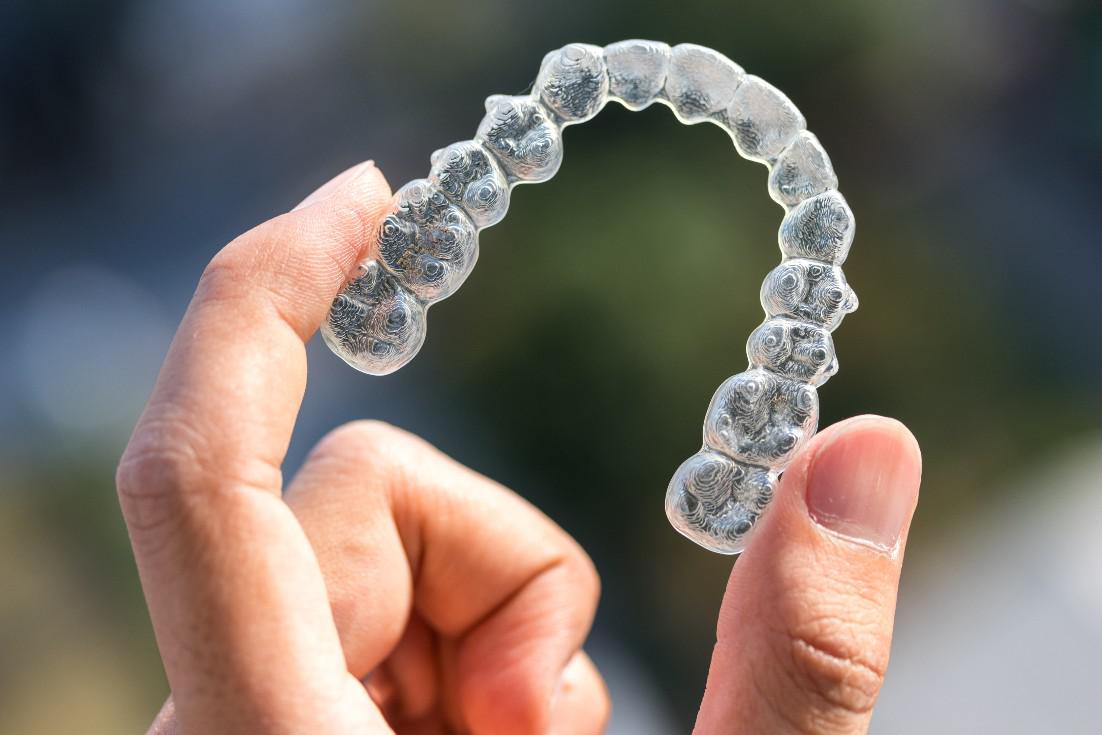 If you’re considering treatment with Invisalign® clear aligners, you’re probably focused on the aesthetic benefits – straighter teeth and a movie star smile! But, the oral health benefits of using Invisalign go beyond a megawatt smile. A popular option for patients with mild-to-moderate alignment issues, Invisalign has also proven to be effective in helping patients improve function and general oral health. In contrast to traditional braces, which consist of metal brackets glued to the teeth and tied together with wires and small rubber bands, Invisalign uses aligner trays made of smooth, BPA-free clear plastic worn over teeth. These trays focus much of the pressure on the upper part of the tooth, pushing it into the correct position from top to bottom, including the root. Invisalign aligners have been shown to alleviate temporomandibular joint (TMJ) pain, reduce excessive teeth grinding, address early periodontal disease, and even improve the outcome of dental implant placement.
If you’re considering treatment with Invisalign® clear aligners, you’re probably focused on the aesthetic benefits – straighter teeth and a movie star smile! But, the oral health benefits of using Invisalign go beyond a megawatt smile. A popular option for patients with mild-to-moderate alignment issues, Invisalign has also proven to be effective in helping patients improve function and general oral health. In contrast to traditional braces, which consist of metal brackets glued to the teeth and tied together with wires and small rubber bands, Invisalign uses aligner trays made of smooth, BPA-free clear plastic worn over teeth. These trays focus much of the pressure on the upper part of the tooth, pushing it into the correct position from top to bottom, including the root. Invisalign aligners have been shown to alleviate temporomandibular joint (TMJ) pain, reduce excessive teeth grinding, address early periodontal disease, and even improve the outcome of dental implant placement.
TMJ Pain
The most common cause of temporomandibular joint syndrome (TMJ) disorders is a misaligned bite. Invisalign is a discreet way to straighten teeth and correct instances of malocclusion, including cross and overbites. Though additional therapeutic options may be recommended, patients often notice that the pain they experienced before treatment is significantly decreased with the use of Invisalign, sometimes disappearing altogether.
Bruxism
While chronic jaw clenching and teeth grinding, known as bruxism, can have a variety of causes, the condition almost always results in damaged teeth. Over time, untreated bruxism can lead to tooth pain and loose or chipped teeth. In some instances, parts of the teeth are literally ground away, and the surrounding bone and gum tissue are destroyed. It can also lead to painful jaw issues, such as temporomandibular joint syndrome (TMJ). In instances where a patient is looking for relief from bruxism and straighter teeth, Invisalign aligner trays are able to address both concerns. Invisalign trays are designed similar to night guards, protecting teeth while a patient sleeps and preventing problems caused by grinding.
Early Periodontal Disease
A common oral health concern, periodontal disease can have a far-reaching impact. It has been connected to a variety of other conditions, including heart disease, diabetes, and rheumatoid arthritis (scientists believe that inflammation may be the link between these systemic diseases). In its early stages, proper brushing and flossing are essential to combat disease progression; however, when teeth are crowded or unevenly spaced, practicing good oral hygiene becomes difficult. If left untreated, periodontitis can ruin your gums, bones, and tissues connected to your teeth. The impact of periodontitis is irreversible, but you can prevent it from advancing. This is where Invisalign comes in; whether used as a supplement or an alternative to a longer orthodontic treatment plan, Invisalign corrects dental alignment which helps to minimize the effects of periodontal disease.
Dental Implants
When a patient needs their smile restored, dental implants may be recommended. While today’s implants look very natural, it’s important to remember that they’re also permanent. The shape, position, and angle of an implant cannot be changed. However, the teeth around the dental implants can be repositioned and adjusted. As a minimally invasive option, Invisalign can be used before, during, or after the implant process to achieve successful, long-term results.
Before – In most instances, Invisalign treatment before dental implants is preferred, as it makes the process easier overall. This gives the orthodontist more flexibility before placing a permanent implant, although there are exceptions. For example, if your dentist is concerned that your bone may deteriorate before implant placement, they may recommend moving forward with the restoration first.
During - If necessary, you can get dental implants while undergoing Invisalign treatment. Your dentist will need to determine the correct order of sequences, keeping in mind that the dental implant will be in a permanent position.
After – Even if you already have dental implants, you may still be a candidate for Invisalign. Your dentist will develop a specific treatment plan to address the teeth around your existing implant and straighten your overall smile.
Schedule A Consultation
In the end, the most suitable orthodontic treatment depends on your specific oral concerns and the problem you need to have corrected. While Invisalign offers a number of benefits, it may not be the best option for you. To see if you’re a good candidate for Invisalign, please contact our office to schedule a consultation.

